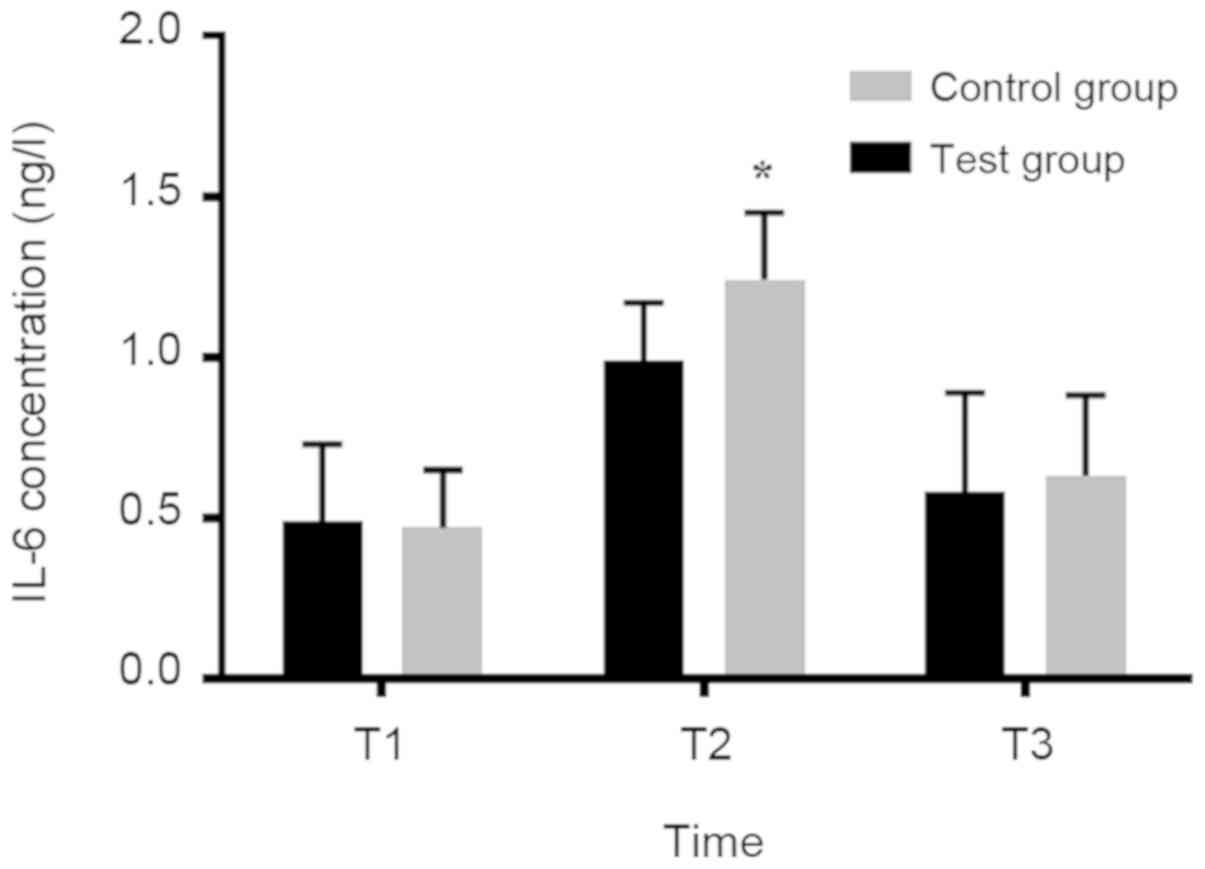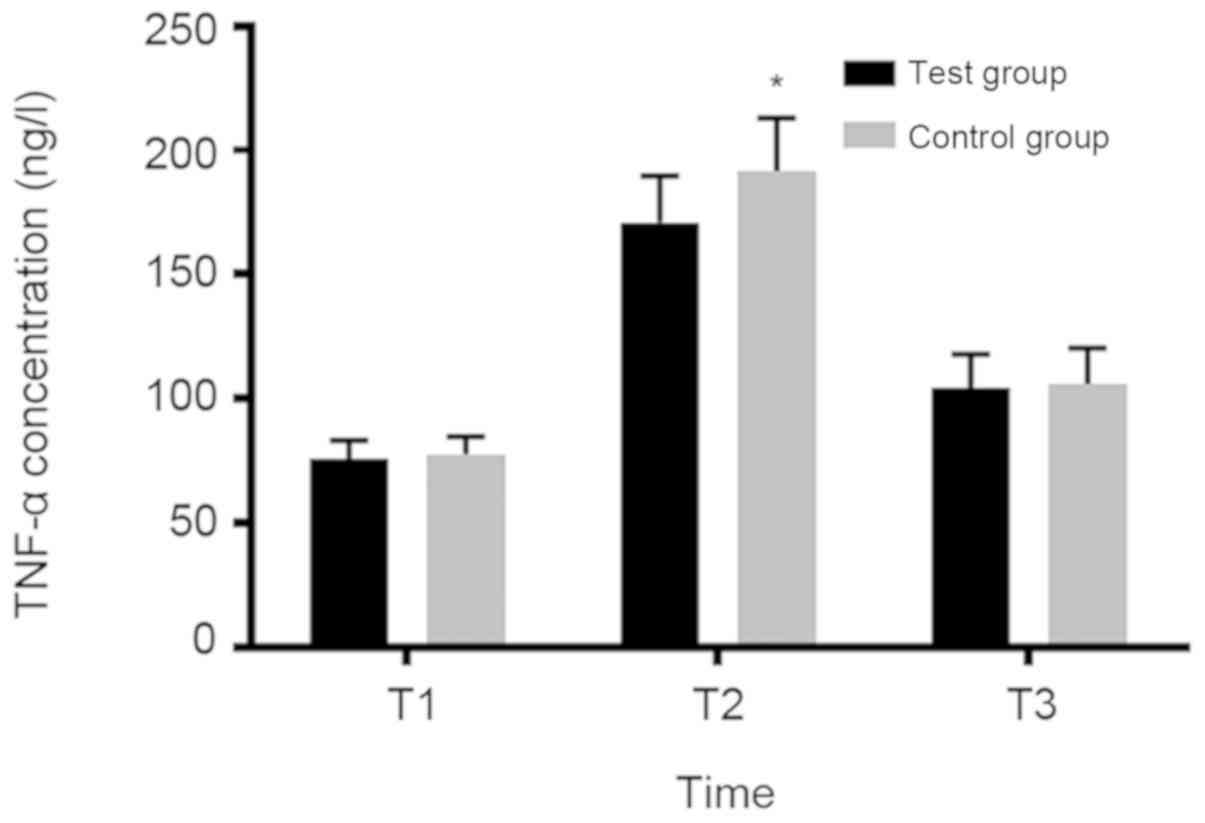|
1
|
He ZY, Jiao QL, Miao Y and Sun Y: Clinical
observation of ropivacaine compuled with sufentanil for painless
childbirth. Pak J Pharm Sci. 29 Suppl 2:707–709. 2016.PubMed/NCBI
|
|
2
|
Palm S, Gertzen W, Ledowski T, Gleim M and
Wulf H: Minimum local analgesic dose of plain ropivacaine vs.
ropivacaine combined with sufentanil during epidural analgesia for
labour. Anaesthesia. 56:526–529. 2001. View Article : Google Scholar : PubMed/NCBI
|
|
3
|
Kampe S, Tausch B, Paul M, Kasper SM,
Bauer K, Diefenbach C and Kiencke P: Epidural block with
ropivacaine and bupivacaine for elective caesarean section:
maternal cardiovascular parameters, comfort and neonatal
well-being. Curr Med Res Opin. 20:7–12. 2004. View Article : Google Scholar : PubMed/NCBI
|
|
4
|
Purdy M, Kokki M, Anttila M, Aspinen S,
Juvonen P, Korhonen R, Selander T, Kokki H and Eskelinen M: Does
the rectus sheath block analgesia reduce the inflammatory response
biomarkers' IL-1ra, IL-6, IL-8, IL-10 and IL-1β concentrations
following surgery? A randomized clinical trial of patients with
cancer and benign disease. Anticancer Res. 36:3005–3011.
2016.PubMed/NCBI
|
|
5
|
Camorcia M and Capogna G: Epidural
levobupivacaine, ropivacaine and bupivacaine in combination with
sufentanil in early labour: a randomized trial. Eur J Anaesthesiol.
20:636–639. 2003. View Article : Google Scholar : PubMed/NCBI
|
|
6
|
Feng SW, Xu SQ, Ma L, Li CJ, Wang X, Yuan
HM, Wang FZ, Shen XF and Ding ZN: Regular intermittent bolus
provides similar incidence of maternal fever compared with
continuous infusion during epidural labor analgesia. Saudi Med J.
35:1237–1242. 2014.PubMed/NCBI
|
|
7
|
Saito M, Okutomi T, Kanai Y, Mochizuki J,
Tani A, Amano K and Hoka S: Patient-controlled epidural analgesia
during labor using ropivacaine and fentanyl provides better
maternal satisfaction with less local anesthetic requirement. J
Anesth. 19:208–212. 2005. View Article : Google Scholar : PubMed/NCBI
|
|
8
|
Wang X, Xu S, Qin X, Li X, Feng SW, Liu Y,
Wang W, Guo X, Shen R, Shen X, et al: Comparison between the use of
ropivacaine alone and ropivacaine with sufentanil in epidural labor
analgesia. Medicine (Baltimore). 94:e18822015. View Article : Google Scholar : PubMed/NCBI
|
|
9
|
Schulpis KH, Vlachos GD, Karikas GA,
Papakonstantinou ED, Vlachos DG, Papassotiriou I, Antsaklis A and
Tsakiris S: The effect of the mode of delivery on maternal-neonatal
interleukin-6, biogenic amine and their precursor amino acid
concentrations. Clin Chem Lab Med. 46:1624–1630. 2008. View Article : Google Scholar : PubMed/NCBI
|
|
10
|
Dunn AB, Paul S, Ware LZ and Corwin EJ:
Perineal injury during childbirth increases risk of postpartum
depressive symptoms and inflammatory markers. J Midwifery Womens
Health. 60:428–436. 2015. View Article : Google Scholar : PubMed/NCBI
|
|
11
|
Prusty BK, Hedau S, Singh A, Kar P and Das
BC: Selective suppression of NF-kBp65 in hepatitis virus-infected
pregnant women manifesting severe liver damage and high mortality.
Mol Med. 13:518–526. 2007. View Article : Google Scholar : PubMed/NCBI
|
|
12
|
Williams M: The combined spinal-epidural
technique for the provision of analgesia in obstetric anaesthesia.
Anaesthesia. 56:5002001. View Article : Google Scholar : PubMed/NCBI
|
|
13
|
Goetzl L: Epidural analgesia and maternal
fever: A clinical and research update. Curr Opin Anaesthesiol.
25:292–299. 2012. View Article : Google Scholar : PubMed/NCBI
|
|
14
|
Liu D, He X, Zheng W, Zhang Y, Li D, Wang
W, Li J and Xu W: Translation and validation of the simplified
Chinese new Knee Society Scoring System. BMC Musculoskelet Disord.
16:3912015. View Article : Google Scholar : PubMed/NCBI
|
|
15
|
Abushaikha LA: Methods of coping with
labor pain used by Jordanian women. J Transcult Nurs. 18:35–40.
2007. View Article : Google Scholar : PubMed/NCBI
|
|
16
|
Kuczkowski KM: Labor analgesia for the
parturient with herbal medicines use: What does an obstetrician
need to know? Arch Gynecol Obstet. 274:233–239. 2006. View Article : Google Scholar : PubMed/NCBI
|
|
17
|
Sharma SK, McIntire DD, Wiley J and Leveno
KJ: Labor analgesia and cesarean delivery: an individual patient
meta-analysis of nulliparous women. Anesthesiology. 100:142–148;
discussion 6A. 2004. View Article : Google Scholar : PubMed/NCBI
|
|
18
|
Yoon HJ, Do SH and Yun YJ: Comparing
epidural surgical anesthesia and spinal anesthesia following
epidural labor analgesia for intrapartum cesarean section: A
prospective randomized controlled trial. Korean J Anesthesiol.
70:412–419. 2017. View Article : Google Scholar : PubMed/NCBI
|
|
19
|
Kokki H, Ruuskanen A and Karvinen M:
Comparison of epidural pain treatment with sufentanil-ropivacaine
infusion with and without epinephrine in children. Acta
Anaesthesiol Scand. 46:647–653. 2002. View Article : Google Scholar : PubMed/NCBI
|
|
20
|
Mantha VR, Vallejo MC, Ramesh V, Jones BL
and Ramanathan S: Maternal and cord serum cytokine changes with
continuous and intermittent labor epidural analgesia: a randomized
study. ScientificWorldJournal. 2012:6079382012. View Article : Google Scholar : PubMed/NCBI
|
|
21
|
Gogarten W, Van de Velde M, Soetens F, Van
Aken H, Brodner G, Gramke HF, Soetens M and Marcus MA: A
multicentre trial comparing different concentrations of ropivacaine
plus sufentanil with bupivacaine plus sufentanil for
patient-controlled epidural analgesia in labour. Eur J
Anaesthesiol. 21:38–45. 2004. View Article : Google Scholar : PubMed/NCBI
|
|
22
|
Boulier V, Gomis P, Lautner C, Visseaux H,
Palot M and Malinovsky JM: Minimum local analgesic concentrations
of ropivacaine and levobupivacaine with sufentanil for epidural
analgesia in labour. Int J Obstet Anesth. 18:226–230. 2009.
View Article : Google Scholar : PubMed/NCBI
|
|
23
|
Yue HL, Shao LJ, Li J, Wang YN, Wang L and
Han RQ: Effect of epidural analgesia with 0.075% ropivacaine versus
0.1% ropivacaine on the maternal temperature during labor: A
randomized controlled study. Chin Med J (Engl). 126:4301–4305.
2013.PubMed/NCBI
|
|
24
|
Zhao Y, Wang W, Wu X, Ma X, Qu R, Chen X,
Liu C, Liu Y, Wang X, Yan P, et al: Mangiferin antagonizes
TNF-α-mediated inflammatory reaction and protects against
dermatitis in a mice model. Int Immunopharmacol. 45:174–179. 2017.
View Article : Google Scholar : PubMed/NCBI
|
















